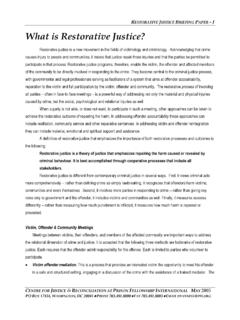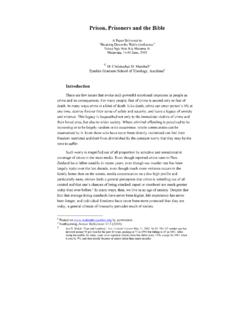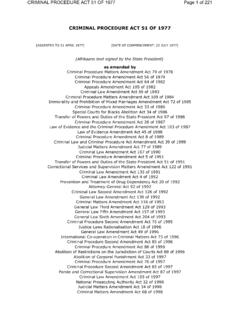Transcription of Module 1 INTRODUCTION TO INTERNATIONAL TERRORISM
1 UNIVERSITY Module SERIES. Counter- TERRORISM 1. INTRODUCTION . TO INTERNATIONAL . TERRORISM . UNITED NATIONS OFFICE ON DRUGS AND CRIME. EDUCATION FOR justice . UNIVERSITY Module SERIES. Counter- TERRORISM Module 1. INTRODUCTION TO. INTERNATIONAL TERRORISM . UNITED NATIONS. Vienna, 2018. This Module is a resource for lecturers. Developed under the Education for justice (E4J) initiative of the United Nations Office on Drugs and Crime (UNODC), a component of the Global Programme for the Implementation of the Doha Declaration, this Module forms part of the E4J University Module Series on Counter- TERRORISM and is accompanied by a Teaching Guide. The full range of E4J. materials includes university modules on Anti-Corruption, Crime Prevention and criminal justice , Cybercrime, Firearms, Organized Crime, Trafficking in Persons/Smuggling of Migrants, and Integrity and Ethics, as well as Counter- TERRORISM .
2 All the modules in the E4J University Module Series provide suggestions for in-class exercises, student assessments, slides and other teaching tools that lecturers can adapt to their contexts, and integrate into existing university courses and programmes. The Module provides an outline for a three-hour class, but can be used for shorter or longer sessions. All E4J university modules engage with existing academic research and debates, and may contain information, opinions and statements from a variety of sources, including press reports and independent experts. Terms and conditions of use of the Module can be found on the E4J website. United Nations, August 2018. All rights reserved, worldwide. The designations employed and the presentation of material in this publication do not imply the expression of any opinion whatsoever on the part of the Secretariat of the United Nations concerning the legal status of any country, territory, city or area, or of its authorities, or concerning the delimitation of its frontiers or boundaries.
3 This publication has not been formally edited. Publishing production: English, Publishing and Library Section, United Nations Office at Vienna. Contents INTRODUCTION 1. KEY ISSUES 2. A brief history of TERRORISM 3. TERRORISM in the nineteenth century 4. The League of Nations and TERRORISM 6. The United Nations and TERRORISM 8. United Nations designated terrorist groups and targeted sanctions 10. Terrorist victimization: victims of TERRORISM 11. EXERCISES AND CASE STUDIES 14. POSSIBLE CLASS STRUCTURE 16. CORE READING 17. TERRORISM 17. Terrorist victimization 17. ADVANCED READING 18. TERRORISM 18. Terrorist victimization 19. STUDENT ASSESSMENT 20. Assessment questions 20. ADDITIONAL TEACHING TOOLS 21. REFERENCES 22. Books/e-Books 22. Book chapters 22. Cases 23. Conventions, charters and treaties 23.
4 Journal/online articles and presentations 24. United Nations materials 24. Reports and remarks 24. iii INTRODUCTION Although the term is not subject to a universally agreed definition, TERRORISM can be broadly understood as a method of coercion that utilizes or threatens to utilize violence in order to spread fear and thereby attain political or ideological goals. Contemporary terrorist violence is thus distinguished in law from ordinary violence by the classic terrorist triangle : A. attacks B, to convince or coerce C to change its position regarding some action or policy desired by A. The attack spreads fear as the violence is directed, unexpectedly, against innocent victims, which in turn puts pressure on third parties such as governments to change their policy or position. Contemporary terrorists utilize many forms of violence, and indiscriminately target civilians, military facilities and State officials among others.
5 The challenges of countering TERRORISM are not new, and indeed have a long history. The term TERRORISM was initially coined to describe the Reign of Terror, the period of the French Revolution from 5 September 1793 to 27 July 1794, during which the Revolutionary Government directed violence and harsh measures against citizens suspected of being enemies of the Revolution. In turn, popular resistance to Napoleon's invasion of the Spanish Peninsula led to a new form of fighter the guerrilla , which derives from the Spanish word guerra, meaning little war (Friedlander, 1976, p. 52). As a weapon of politics and warfare, however, the use of TERRORISM by groups can be traced back to ancient times, and as noted by Falk, in various forms, TERRORISM is as old as government and armed struggle, and as pervasive.
6 (Falk, 1990, pp. 39, 41). The focus of this Module , and of the University Module Series as a whole, is on terrorist violence and the threats carried out by non-State groups and the response of the INTERNATIONAL community, especially States, regional organizations and the United Nations system. LEARNING OUTCOMES. Understand the semantic and historical development of the word TERRORISM . Analyse the concept and underpinning legal principles of INTERNATIONAL crimes of TERRORISM , whether at the national or INTERNATIONAL level. Explain treaty-based crimes relevant for prosecuting acts of TERRORISM , whether at the national or INTERNATIONAL level. Identify and discuss some of the reasons for, and implications of, the absence of a universally accepted definition of TERRORISM at the global level.
7 Familiarize students with interdisciplinary perspectives ( , victimology). 1. 2 COUNTER- TERRORISM UNIVERSITY Module SERIES. Key issues The purpose of this Module is to introduce students to the key concepts and principles that underpin INTERNATIONAL instruments and institutions concerned with the complex topics of TERRORISM and how to counter TERRORISM , as well as any hard, security-based, responses adopted by States when confronted with acts of TERRORISM . When considering the concept of TERRORISM , it is important to note that as yet, there is no global consensus regarding an agreed definition of the term TERRORISM for legal purposes (see further Module 4). This Module will also provide a brief overview of modern TERRORISM and its implications for the INTERNATIONAL community. Regarding the prosecution of the perpetrators of acts of TERRORISM , it is vital to understand how, why and to what extent, the impact of a lack of a universally agreed global legal definition of the term may have had on the effective investigation and prosecution of terrorist offences.
8 Principally, prosecuting chargeable crimes must rely on the judicial forums available. A decision to prosecute a terrorist offence will depend, among other factors, on legal and non-legal considerations. Furthermore, the State of custody must decide either to prosecute (as a terrorist or an ordinary crime) or to extradite elsewhere for prosecution persons accused of serious, transboundary terrorist crimes. Choosing between prosecuting on the grounds of terrorist or of ordinary crimes also involves wider issues such as the distinction between armed and non-armed conflict, the State use of counter-terrorist force and the return of terrorists who have been fighting abroad. Notwithstanding the absence of a globally agreed, legal definition of TERRORISM , an effective and prevention-focused INTERNATIONAL response to TERRORISM is highly desirable, particularly one guided by a normative legal framework and embedded in the core principles of the rule of law, due process and respect for human rights.
9 Many INTERNATIONAL and regional legal instruments already exist which are dedicated to countering and deterring TERRORISM (see further Modules 4 and 5), primarily through the investigation and prosecution of those suspected of committing related crimes by means of State criminal justice processes. While such INTERNATIONAL and regional instruments provide for effective prevention mechanisms, including interventions targeting specific types of criminal acts ( , hostage-taking, the hijacking of planes or ships, terrorist bombings and the funding of TERRORISM ), States implement their treaty obligations differently. As a result, criminal justice responses and outcomes in investigating and prosecuting TERRORISM -related crimes may vary between States. Since the terrorist attacks of 11 September 2001, INTERNATIONAL support for more effective counter- TERRORISM measures and responses has led to greater INTERNATIONAL cooperation in counter-terrorist matters, and there is certainly evidence of a widespread hardening of approaches to the prosecution of terrorists.
10 This is important in a context that is witnessing the increased export and globalization of TERRORISM by groups such as Al-Qaida and the Islamic State in Syria and the Levant (ISIL, or Da'esh), a trend that shows no sign of abating. In response , States are utilizing a range of counter- TERRORISM measures, from criminal justice Module 1 INTRODUCTION TO INTERNATIONAL TERRORISM 3. mechanisms which should represent the usual response , including as a means of TERRORISM prevention to harder security-based measures accompanied by increased military spending. Although, as discussed in Module 6, military responses may be entirely appropriate where the requisite legal criteria are met, such as the threshold of violence necessary to constitute an armed conflict, these are also accompanied by increased complexities.



















